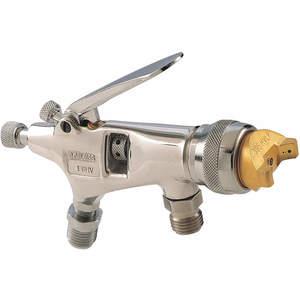DeVilbiss EGHV-531-397E HVLP spray gun is a high-precision tool used to obtain a finer finish than conventional spray guns. It is ideal for the automotive, aerospace, woodworking and furniture manufacturing industries.
Features:
- It features a versatile siphon / pressure fluid delivery for flexibility for painting applications.
- This DeVilbiss HVLP spray gun has an 8 fl oz cup capacity for extended painting sessions without frequent refills.
Frequently Asked Questions:
Q. What safety precautions should I take when using DeVilbiss EGHV-531-397E HVLP spray gun?
A.
- Wear appropriate personal protective equipment (PPE) such as goggles, gloves and a respirator to shield against paint fumes and overspray.
- Ensure proper ventilation in the workspace to minimise inhalation of harmful vapors and maintain air quality.
- Keep flammable materials away from ignition sources and follow fire safety protocols to prevent accidents.
- Handle paints and chemicals with care, avoiding direct skin contact and promptly cleaning up spills.
- Regularly inspect and maintain this DeVilbiss HVLP spray gun to ensure optimal performance and prevent malfunctions.
- Provide operators with adequate training in the safe use of the spray gun and promote ongoing safety education.
- Have emergency procedures in place and access to first aid resources in case of accidents or chemical exposure.
Q. What is the difference between HVLP and conventional spray gun?
A. HVLP spray gun operates at lower pressure, resulting in reduced overspray and better transfer efficiency compared to conventional spray guns. This leads to less paint wastage and a more environmentally friendly painting process.
Q. How do I clean and maintain this spray gun?
A.
- Flush out the remaining paint with a solvent after each use and wipe down the exterior with a clean cloth.
- Disassemble the spray gun according to the manufacturer's instructions, separating removable parts.
- Soak disassembled parts in a cleaning solution appropriate for the paint type used.
- Clean each part thoroughly, using brushes or specialised tools to remove paint and debris.
- Rinse the parts with clean water or solvent to remove any remaining residue.
- Allow cleaned parts to air dry completely or use compressed air to remove moisture.
- Carefully reassemble the spray gun, ensuring proper alignment and tightening of parts.
- Store the cleaned and assembled spray gun in a clean, dry and well-ventilated area, using protective covers to prevent contamination.



